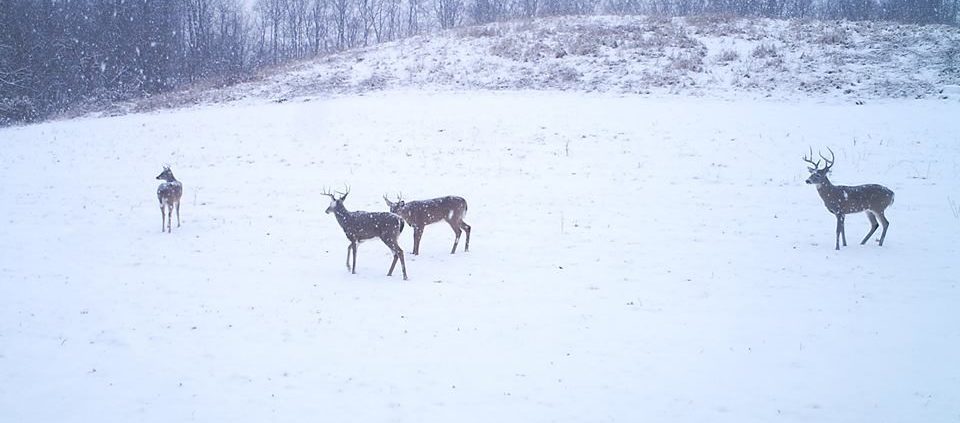Strategies Deer Use to Survive the Winter Months and What You Can Do to Help Them
How Deer Survive the Winter
Many of us are settling in to the heart of winter, which means dealing with the brutal cold and snow. Most people have a friend or family member that can barely make the trip from their vehicle to their office without complaining about how cold it is. Lucky for them, they have the luxury of climate control! White-tailed deer aren’t so lucky. They endure the cold and snow 24 hours a day, 7 days a week. It’s no surprise that winter can be a devastating time for deer, so how do they survive? This article will discuss some of the adaptations deer have to help them through winter weather.
Fall and Early Winter Feeding Habits
Surviving the dead of winter is no easy task, as such, deer begin preparing for winter in the fall months. This is when both bucks and does push to put on weight by eating high fat foods like acorns when they are available. But it’s not only the foods they eat that help them put on a layer of fat. Deer also display what’s called an obligatory weight response. Essentially, all deer will start converting food to fat to prepare for winter, regardless of the quality of nutrition they have available. This is just one adaptation deer have to help them prepare for the coming winter months.
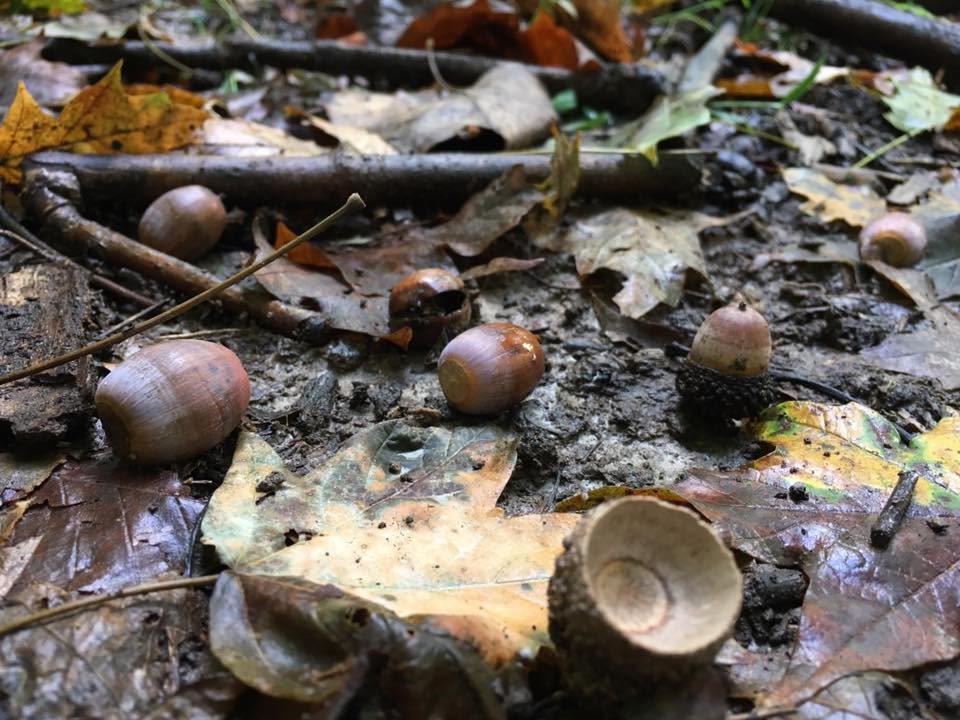
In particular, bucks have it pretty rough during this time period because they can lose up to 25% of their body weight from chasing does during the rut. This, in part, is why you see mature bucks hitting food sources during daylight in December. They have to try to replenish some of the fat reserves they lost during the rut so they have a chance to survive the rest of the winter.
January
Although January may seem like a brutal winter month to you, it is just the start for deer. Luckily, most deer still have plenty of their fat reserves to burn through in January, but deer also have some other strategies to help them conserve energy during this month.
Once temperatures start plummeting and snow depths increase, deer dramatically change their behavior. Deer will herd-up and move more during daylight hours to help conserve energy they need to maintain their body temperature. Deer will also start hitting high-energy content food such as soybeans or cornfields. These high-energy food sources won’t necessarily help replenish their fat reserves, but they will help deer maintain the caloric intake they need to survive the day.
Although many of us envision herds of deer feeding in a picked soybean or cornfield during the winter, agriculture only accounts for a portion of a deer’s diet. So what else are they eating during this energetically demanding time? Woody browse is the answer. So what is woody browse? Woody browse is pretty much exactly what it sounds like. It’s any type of woody vegetation where deer can browse on the tips or terminal buds of the plant. The type of woody browse species a deer prefers depends on what part of the country you find yourself in but some examples of high quality woody browse species in northern states are aspen seedlings, eastern hemlock, and if you find yourself in the far north, Canada yew. In fact, regardless of the amount of agricultural crops available in your area, woody browse will still make up at least 40% of a deer’s diet. Deer have adapted over hundreds of years to eating woody browse and this type of forage helps maintain the pH level in their highly complex four-chambered stomach. The importance of woody browse to a deer is exactly why deer biologists and managers stress the need for habitat management. The more habitat management you engage in, the more woody browse there is available to deer.
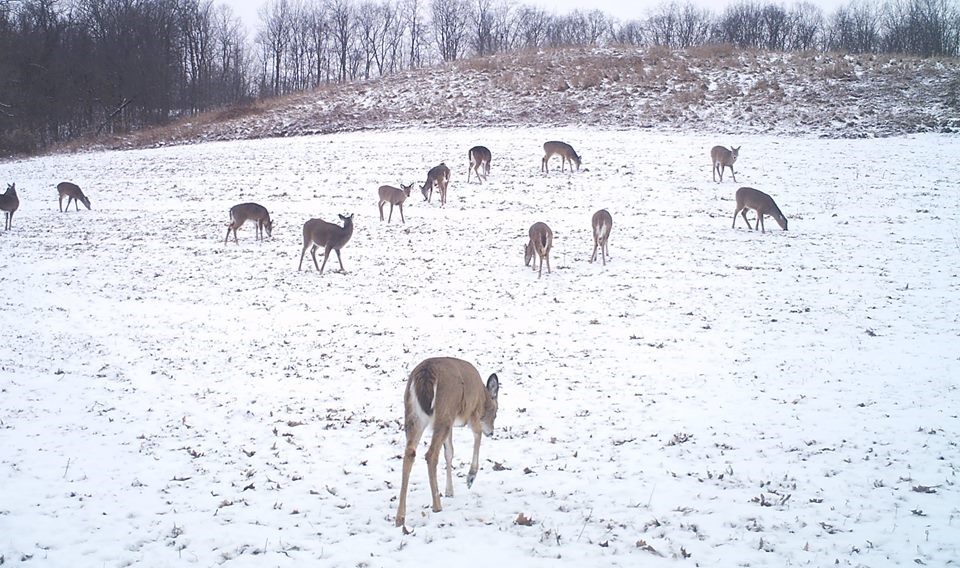
Another thing most people don’t consider is how difficult it is for deer to consume enough waste grain from soybean or corn fields to survive. Throughout most of the year, deer need to consume 6 to 10 pounds of food per day. Luckily, a deer’s metabolism slows down during the winter months so they don’t need to consume as much food. But still, it’s hard to fathom how many kernels of corn or bean pods it would take to weigh even 3 to 6 pounds. Now combine that with the fact that most agricultural fields are plowed after harvest, making finding waste grain even more difficult. It’s easy to see why woody browse is so important!
February
Most people realize how brutal February is for winter weather. Blizzards, snow, cold temperatures, and heavy winds can make for some nasty days during this month. But February can also bring some nice weather giving you hope that spring is right around the corner. However, this isn’t necessarily the case for deer. Deer have already burned through a lot of their winter fat reserves during January, so February can be the start of trouble.
Migrations
You may not think of white-tailed deer as a stereotypical migratory species. Generally, when people think of migratory species of ungulates, they think of caribou, elk, pronghorn, or mule deer. Biologists have known for a while that deer in far northern states like Minnesota, Wisconsin, Michigan, Pennsylvania, and New York will herd up and migrate during late January and February to yarding areas. These yarding areas allow hundreds of deer to congregate which helps them survive the winter. Yarding areas historically provided woody browse to deer, but also allowed deer to create travel corridors into and out of the yarding area. These travel corridors consist of beaten down snow paths that allow for easy travel. Easy travel also allows deer to more easily escape predators such as wolves. Finally, yarding areas also provide deer with an increased ability to thermoregulate, or maintain their body temperatures, by providing cover and allowing for several animals to bed next to each other.
Although deer migrations in the north woods are common and have been documented for a while now, deer in agriculturally dominated regions like the Dakotas and southern Minnesota were not thought to migrate during the winter months. But recent research has shown that in states like North Dakota and South Dakota, a high percentage of deer will still migrate over winter. We generally think of the Dakotas as being agriculturally dominated regions, so why would deer need to migrate? Well research hasn’t quite nailed this one down, but one of the most logical hypotheses is related back to food and cover. As already mentioned, many agricultural fields are plowed immediately following harvest. This leaves a barren landscape as agriculture can comprise up to 60% of land use in some of these regions. Regardless, deer may still have plenty of resources to carry them through most of January and into February, but what happens when the food runs out? You guessed it! It’s time to find greener pastures, quite literally. So even deer in agriculturally heavy regions will migrate to find the necessary resources to survive the rest of winter. Although food is at the top of the list, don’t discount the importance of cover during winter months. Research from the Dakotas has also shown that the probability of adult does migrating decreases with increasing amounts of forested areas found within their winter home range. This emphasizes not only the importance of forested areas in helping deer thermoregulate, but also emphasizes the potential importance of woody browse during the winter months.
March
In like a lion, out like a lamb. This old adage describes why March marks the danger zone for overwinter survival of white-tailed deer. Regardless of how severe the December, January, and February months were deer are actually pretty well equipped to survive these months regardless of what type of winter weather is thrown at them. Deer burn through their fat reserves slow and steady. Then March hits. The beginning of March is still generally cold and nasty meaning deer are still having to use the last bit of their stored fat reserves. Usually by the end of March temperatures are warming up and snow is melting. Warming temps means deer need to use less energy to keep warm and also means that snow is melting. Decreasing snow depths means deer can find food easier because they don’t have as much snow to paw through to reach it. As long as temperatures steadily rise throughout March, then deer will be in the clear and will likely survive another winter. But what if severe winter weather persists throughout March?
Most biologists agree that it’s not necessarily the winter severity of January and February that can be deadly to deer, rather it’s how long severe winter persists into the spring. Deer have adapted to store enough fat reserves to survive the previous months and then to start replenishing those reserves once spring hits in late March and April. However, if severe winter weather continues to persist throughout March then deer can find themselves in trouble. By late March, most food resources have been depleted, regardless of the available food resources in that region. This means that if a deer can’t find any food then they are in real danger of starving. So what can you do help deer through this stressful period?
The Do’s and Don’ts of Feeding Deer
Unfortunately, there are more don’ts than do’s when it comes to trying to help deer survive a brutal winter. The biggest don’t is NOT to feed deer a high quantity of high energy foods like shelled corn. It’s the same story every year; you hear about somebody with good intentions putting out shelled corn for deer to help them survive the winter but then find several deer dead just feet away from the corn pile. You may be asking yourself why deer can survive just fine eating waste grain and standing corn, but shelled corn represents a major threat to survival? Well believe it or not, although corn represents a high energy food source that can help deer survive energetically stressful time periods like winter, in general, corn is not the best food for deer. That’s because corn is hard to digest and changes the pH of their stomach. In turn, the bacteria composition needs to change in a deer’s stomach to help them digest the corn. When deer are feeding on waste grains, they generally aren’t consuming enough corn at a fast enough rate to do any harm. And when deer are feeding in standing corn, they are also usually consuming parts of the corn stalk that serves as roughage and helps a deer maintain the pH in their stomach. The issue is when deer have essentially unlimited access to shelled corn. They will eat too much corn without having any roughage available, which increases the pH in a deer’s stomach so fast that it can kill the deer. This change in pH is known as acidosis causes deer to die almost instantly. Although these people have good intentions, their actions prove to be deadly.
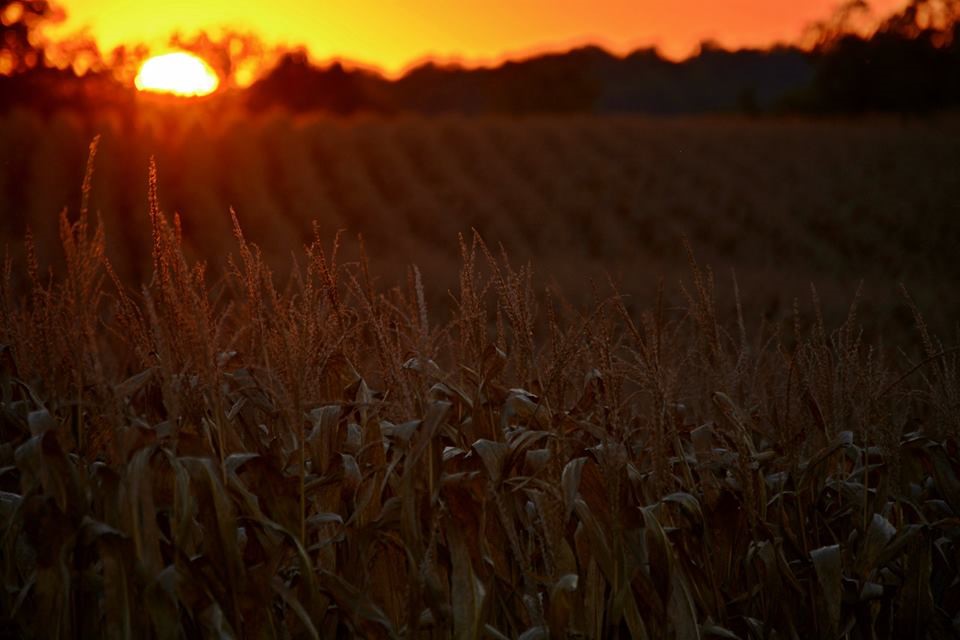
Generally speaking, there is more harm than good that comes from feeding wildlife. So avoid feeding deer with piles of corn to help them survive harsh winters. But don’t worry, it’s not all doom and gloom because there are a few things you can do to help deer survive the winter, particularly if you have the ability to manage your hunting property.
One of the easiest things you can do is to plant some food plots into corn or beans and leave them stand throughout winter. Depending on the size of the plot they may serve as an important food resource throughout winter. If you don’t have the ability to plant food plots where you hunt but there is still abundant agriculture, then talk to the farmer about working out a deal to leave some standing corn or beans. This may be something as simple as paying the farmer for their losses of not harvesting a certain amount of crops. Who knows, you may even get lucky and the farmer will do it at no cost to you.
A more permanent fix is engaging in habitat management. Talking with your area wildlife biologist and area forester will help you to better understand what parts of your timber and which specific trees may need to be cut. Cutting timber to improve habitat may seem counterintuitive, but in reality, cutting timber allows sunlight to hit the forest floor and initiates the growth of the understory. High quality deer browse will regenerate, including important woody browse species. Remember, a deer can’t eat anything higher than five or six feet off the ground so if you walk into your woods and can clearly see for a hundred yards or more without any vegetation obstructing your view, then you aren’t providing any food or cover to your deer herd. Habitat management takes a lot of effort, but also has long-term benefits.
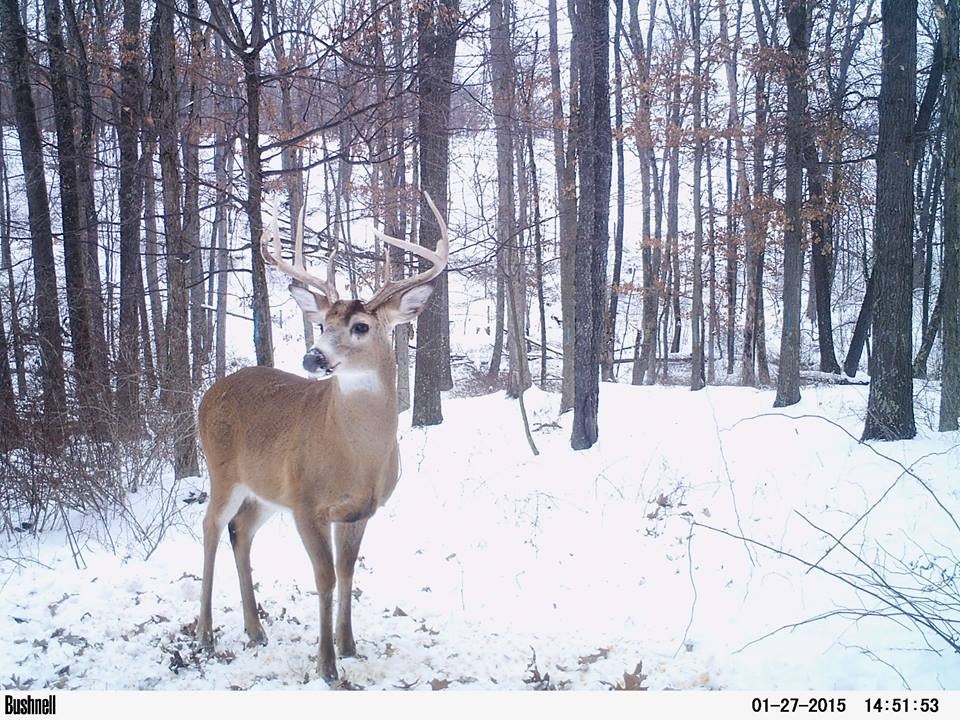
Believe it or not, deer have several adaptations and are fairly well equipped to survive the winter months. But even with all of these adaptations, they can still find themselves in trouble if winter weather persists into late March and April. Although you should avoid feeding deer to help them survive, there are a couple of things you can do if you are worried about deer making it through the winter on your hunting property. If you have the ability to do so, make sure you’re leaving crops like soybeans and corn standing throughout the winter. These are high-energy content foods and will help deer survive. You should also consider conducting habitat management to provide cover and woody browse throughout these months. Deer are amazing animals and hopefully this article helps you better understand how they can survive brutal winters!

